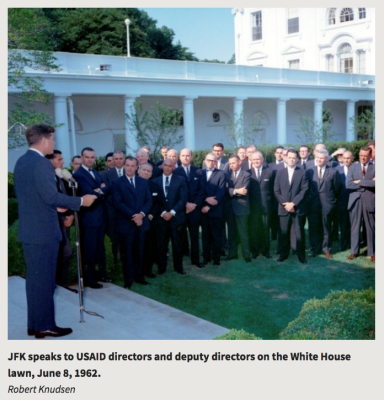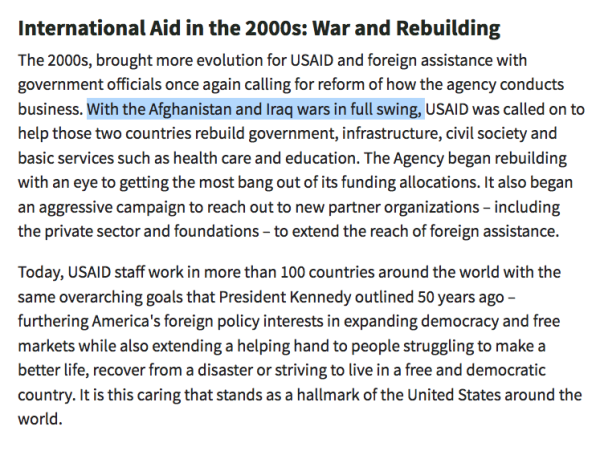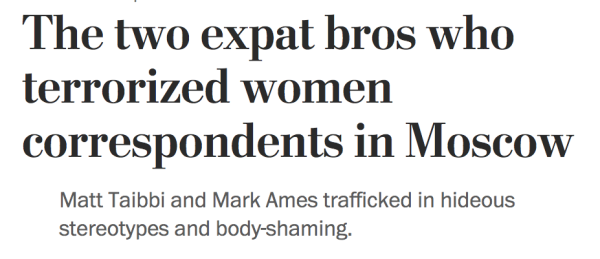USAID - United States Agency for International Development
Agency History & Mission
Celebrating Fifty Years of Progress
 When the United States Agency for International Development (USAID) was created, it brought together several existing foreign assistance organizations and programs. Until then, there had never been a single agency charged with foreign economic development, so with the passage of the Foreign Assistance Act of 1961 (pdf) by Congress, U.S. foreign assistance activities underwent a major transformation.
When the United States Agency for International Development (USAID) was created, it brought together several existing foreign assistance organizations and programs. Until then, there had never been a single agency charged with foreign economic development, so with the passage of the Foreign Assistance Act of 1961 (pdf) by Congress, U.S. foreign assistance activities underwent a major transformation.
Leading this transformation was President John F. Kennedy. President Kennedy recognized the need to unite development into a single agency responsible for administering aid to foreign countries to promote social and economic development. On November 3, 1961, USAID was born and with it a spirit of progress and innovation.
November 3, 2011 marked USAID's 50th Anniversary of providing U.S. foreign development assistance From the American People. Our workforce and USAID's culture continues to serve as a reflection of core American values–values that are rooted in a belief for doing the right thing.
“There is no escaping our obligations: our moral obligations as a wise leader and good neighbor in the interdependent community of free nations – our economic obligations as the wealthiest people in a world of largely poor people, as a nation no longer dependent upon the loans from abroad that once helped us develop our own economy – and our political obligations as the single largest counter to the adversaries of freedom.” – John F. Kennedy
Early International Development Efforts
The modern-day concept of international development assistance took shape after World War II ended in 1945. George C. Marshall, the Secretary of State from 1947 to 1949 provided significant financial and technical assistance to Europe after the war. Famously known as the Marshall Plan, this was a successful effort that allowed Europe to rebuild its infrastructure, strengthen its economy, and stabilize the region.
International Aid Becomes Foreign Policy
Building on the success of the Marshall Plan, President Harry S. Truman proposed an international development assistance program in 1949. The 1950 Point Four Program focused on two goals;
Creating markets for the United States by reducing poverty and increasing production in developing countries Diminishing the threat of communism by helping countries prosper under capitalism.
International Aid in the 1960s: An Agency is Born
In 1961, President Kennedy signed the Foreign Assistance Act into law and created USAID by executive order. Once USAID got to work, international development assistance opportunities grew tremendously. The time during the Kennedy and Johnson administrations became known as the “decade of development.” International Aid in the 1970s: A Shift to Basic Human Needs
In the 1970s, the USAID began to shift its focus away from technical and capital assistance programs. Instead, U.S. development assistance stressed a “basic human needs” approach, which focused on; Food and nutrition, Population planning, Health, Education, Human resources development
International Aid in the 1980 - A Turn to Free Markets
In the 1980s, foreign assistance sought to stabilize currencies and financial systems.
It also promoted market-based principles to restructure developing countries' policies and institutions. During this decade, USAID reaffirmed its commitment to broad-based economic growth, emphasizing employment and income opportunities through a revitalization of agriculture and expansion of domestic markets. In this decade, development activities were increasingly channeled through private voluntary organizations (PVOs), and aid shifted from individual projects to large programs.
International Aid in the 1990s: Sustainability and Democracy
In the 1990s, USAID’s top priority became sustainable development, or helping countries improve their own quality of life. During this decade, USAID tailored development assistance programs to a country's economic condition, which meant that -
Developing countries received an integrated package of assistance Transitional countries received help in times of crisis Countries with limited USAID presence received support through nongovernmental organizations (NGOs)
USAID played a lead role in planning and implementing programs following the fall of the Berlin Wall in 1989. USAID programs helped establish functioning democracies with open, market-oriented economic systems and responsive social safety nets.
International Aid in the 2000s: War and Rebuilding
 The 2000s, brought more evolution for USAID and foreign assistance with government officials once again calling for reform of how the agency conducts business. With the Afghanistan and Iraq wars in full swing, USAID was called on to help those two countries rebuild government, infrastructure, civil society and basic services such as health care and education. The Agency began rebuilding with an eye to getting the most bang out of its funding allocations. It also began an aggressive campaign to reach out to new partner organizations – including the private sector and foundations – to extend the reach of foreign assistance.
The 2000s, brought more evolution for USAID and foreign assistance with government officials once again calling for reform of how the agency conducts business. With the Afghanistan and Iraq wars in full swing, USAID was called on to help those two countries rebuild government, infrastructure, civil society and basic services such as health care and education. The Agency began rebuilding with an eye to getting the most bang out of its funding allocations. It also began an aggressive campaign to reach out to new partner organizations – including the private sector and foundations – to extend the reach of foreign assistance.
Today, USAID staff work in more than 100 countries around the world with the same overarching goals that President Kennedy outlined 50 years ago – furthering America's foreign policy interests in expanding democracy and free markets while also extending a helping hand to people struggling to make a better life, recover from a disaster or striving to live in a free and democratic country. It is this caring that stands as a hallmark of the United States around the world. USAID Today
In 2013, USAID launched a new mission statement to end extreme poverty and promote resilient, democratic societies. This work includes steps to diversify the streams of capital that finance development, improve the way progress is measured and invest in force multipliers like science, technology, innovation and partnership to accelerate impact.
Even as the Agency continues to respond to a record number of humanitarian disasters and ongoing crises, the work to solidify - and build - on progress continues. 1)
USAID Pandemic PREDICT Program
PREDICT was an epidemiological research program funded by a United States Agency for International Development (USAID) grant. Launched in 2009, the program was described as an early warning pandemic in response to the influenza A virus subtype H5N1 “bird flu” outbreak in 2005. Extensive program details at PREDICT wiki page.
USAID CIA Alliance
The murderous history of USAID, the US Government agency behind Cuba's fake Twitter clone
PANDO By Mark Ames - April 8, 2014
“In a number of countries, including Venezuela and Bolivia, USAID is acting more as an agency involved in covert action, like the CIA, than as an aid or development agency.” —Mark Weisbrot, Center for Economic and Policy Research
Presumably the US government had been studying Twitter’s ability to supercharge its users with outrage vapors here in the Free World, where legions of credulous idiots spend their waking hours chasing the outrage dragon. It was only a matter of time before some DC spooks and Northern Virginia contractors would see the angles.
Of course, the ZunZuneo plan failed. ZunZuneo collapsed, a bunch of money went missing (likely into the coffers of the Castro regime’s state-controlled telecoms firm, or so they say), and the Communist Cuban menace still threatens the Free World’s slick underbelly.
What really seems to be weirding people out here is the shock realization that USAID — the nice, humanitarian, democracy-promoting arm of American idealism — also engages in sleazy regime-change and subversion. The sorts of nefarious covert activities folks normally associate with the CIA.
Not that this is news to PandoDaily readers, of course: Earlier this year, we broke the story about USAID co-investing with Omidyar Network in Ukraine NGOs that organized and led the Maidan revolution in Kiev, resulting in the overthrow of President Viktor Yanukovych. That revolution hasn’t turned out so well — thanks to the “success” of the USAID-Omidyar-funded revolution, there’s talk of the West going to war with nuclear-armed Russia, Ukraine is losing entire chunks of territory like the proverbial leper on a waterslide, Kiev is run by a coalition of costume-party fascists and a handful of billionaire Mafia dons—and Vladimir Putin has never been more popular, or more tyrannical.
Given USAID’s “success” in Ukraine, perhaps we should be thankful that ZunZuneo failed as miserably and comically as it did.
For me, there wasn’t anything all that surprising about the recent USAID revelations. I spent over a decade in Russia and the former Soviet Union, and witnessed for myself the good, bad and ugly that USAID funded—mostly the bad and the ugly. I assumed that most reporters already understood what USAID gets up to overseas, often alongside private nonprofits like those run by Soros, Gates, Rockefeller, Ford and more recently, Omidyar.
The truth is, USAID’s role in a covert ops and subversion should be common knowledge—it’s not like the record is that hard to find. Either USAID has developed those Men In Black memory-zappers, or else—maybe we don’t want to remember.
This selective amnesia doesn’t do anyone else any good however, so I figured it might be useful to offer a brief look back at some of USAID’s darkest, ugliest moments. It's important to note that not everything USAID does is patently evil — in fact, there are many programs that could even be described as good. But USAID, as with any agency of American power, is fully capable of and will continue to be an instrument of geopolitical and corporate force.
As Big Tech becomes increasingly intertwined with USAID’s missions around the world — particularly as USAID’s programs and language merge with the lexicon and interests of Silicon Valley (such as “Global Development Lab,” USAID's new “DARPA-like” research arm) — now’s a good time to refresh our memories about USAID’s dark past.
I should warn you: some of what follows is horrifying.
(list of titles full ghastly details see Mark)
1. Dan Mitrione and The Office of Public Safety (OPS)
“The precise pain, in the precise place, in the precise amount to achieve the desired effect.” —Dan Mitrione, USAID official
Of the many dark-red blotches in USAID’s record, none compares to the agency’s Office of Public Safety (OPS) program — and its most notorious official, Dan Mitrione.
2. Other Offices of Public Safety (OPS’s)
“At one time, many AID field offices were infiltrated from top to bottom with CIA people. The idea was to plant operatives in every kind of activity we had overseas, government, volunteer, religious, every kind.” —John Gilligan, director of USAID under Jimmy Carter [quoted in William Blum’s book “Killing Hope”]
Multiply Dan Mitrione’s story by all the other Dan Mitrione’s working in all the other USAID Offices of Public Safety that we rarely hear about, and you start to get a sense of how small USAID’s failed Twitter revolution in Cuba is by the agency's standards.
A few more examples of other USAID police training ventures through the Office of Public Safety - The Vietnam War: USAID trained police and ran civilian jails. USAID also participated in the “soft” side of the Phoenix Program
- Laos: In 1967, USAID Co-funded with the CIA a suspected private opium airliner, Xieng Khouang Air Transport.
- Guatemala: By 1970, USAID trained over 30,000 Guatemalan police to suppress local leftists, according to William Blum’s book “Killing Hope.” Just over a decade later, Guatemalan death squads under US-backed dictator Rios Montt unleashed a genocide on the Mayan peasants.
According to Victoria Sanford's “Buried Secrets: Truth and Human Rights in Guatemala,” USAID programs supported the death squads as they carried out the genocide.
3. Haiti
After populist left-wing candidate Jean-Bertrand Aristide won the first democratic elections in Haiti in 1990, USAID and the National Endowment for Democracy began pouring funds into opposition groups opposed to Aristide.
4. Peru mass-sterilization
In the early 1990s, Alberto Fujimori won Peru’s presidency, and quickly imposed harsh shock therapy measures that impoverished millions. Peru’s impoverished masses weren’t responding to shock therapy the way Fujimori and the neoliberal consensus thought they should.
5. Russia
There were many ways to transform Russia in the 1990s, but thanks to funding from USAID, the path chosen was the most brutal and disastrous of all: Shock therapy, mass privatization, and the mass impoverishment of 150 million people.
As Janine Wedel and my former eXile partner Matt Taibbi documented, USAID funding and support empowered a single “clan” from St. Petersburg led by Anatoly Chubais, who oversaw the complete destruction of Russia’s social welfare system, and the handing over of lucrative assets to a tiny handful of oligarchs.
Under Chubais’ stewardship, Russia’s economic output declined some 60% in the 1990s, while the average Russian male life expectancy plummeted from 68 years to 56 years. Russia’s population went into a freefall, Russia’s worst death-to-birth ratio at any time in the 20th Century — which is amazing when you think that USAID’s privatization program had to compete with the ravages Hitler, Dzerzhinsky and Stalin wreaked on Russia.
USAID funded Chubais through public-private organizations and a Harvard program that was so patently corrupt, Harvard and its program directors including economist Andrei Shleifer were sued by the US Department of Justice for “conspiring to defraud” the US government (not to mention Russians).
USAID also paid public relations giant Burson-Marsteller to sell the disastrous voucher program to the Russian public, in a mass media advertising blitz that promoted Chubais’ political party on the eve of parliamentary elections. It was this USAID funded privatization, and the USAID-backed Russia “democrats,” which soured Russians on market capitalism and democracy (renamed “dermokratsia” or “shitocracy” in Russian).
6. Palestine
In 2006, the Washington Post revealed a covert $2 million USAID propaganda effort to help the “moderate” Palestinian Authority’s election bid against Hamas:
The approximately $2 million program is being led by a division of the U.S. Agency for International Development. But no U.S. government logos appear with the projects or events being undertaken as part of the campaign, which bears no evidence of U.S. involvement and does not fall within the definitions of traditional development work.
U.S. officials say their low profile is meant to ensure that the Palestinian Authority receives public credit for a collection of small, popular projects and events to be unveiled before Palestinians select their first parliament in a decade. Internal documents outlining the program describe the effort as “a temporary paradigm shift” in the way the aid agency operates. The plan was designed with the help of a former U.S. Army Special Forces officer who worked in postwar Afghanistan on democracy-building projects. 2)
Enemies of Empire Archive & Trivia
 Mark Ames - Pando Archive 3)
Mark Ames - Pando Archive 3)
Smear by Washington Post's Kathy Lally against Mark Ames and Matt Taibbi hits w her best shot.. body shaming!!
by Kathy Lally Twenty years ago, when I was a Moscow correspondent for the Baltimore Sun, two Americans named Matt Taibbi and Mark Ames ran an English-language tabloid in the Russian capital called the eXile.
They portrayed themselves as swashbuckling parodists, unbound by the conventions of mainstream journalism, exposing Westerners who were cynically profiting from the chaos of post-Soviet Russia.
A better description is this: The eXile was juvenile, stunt-obsessed and pornographic, titillating for high school boys.4)
